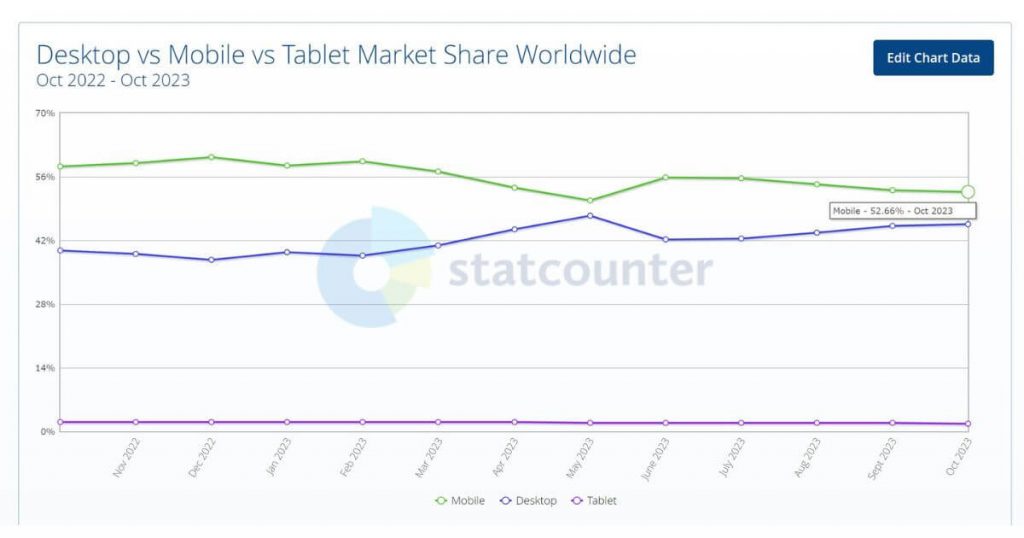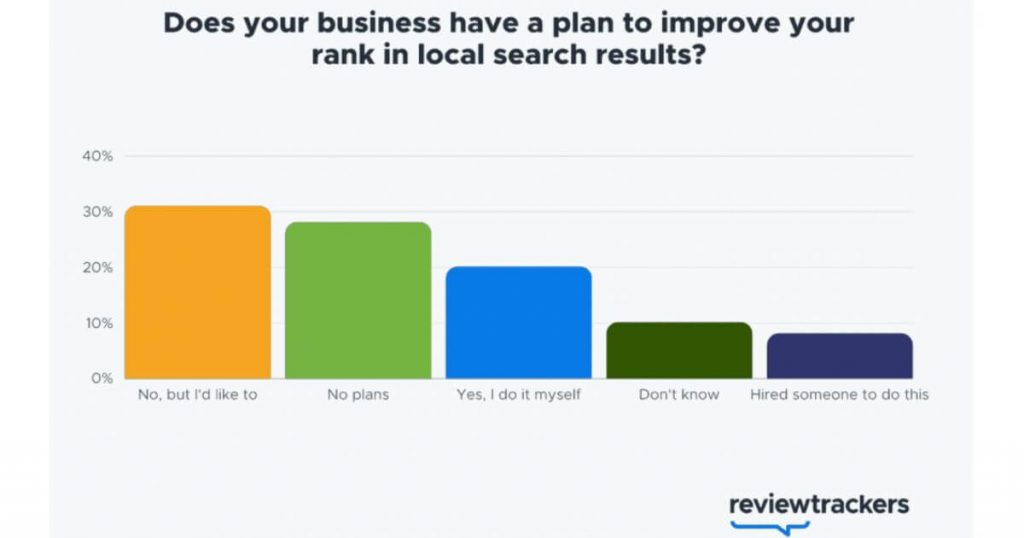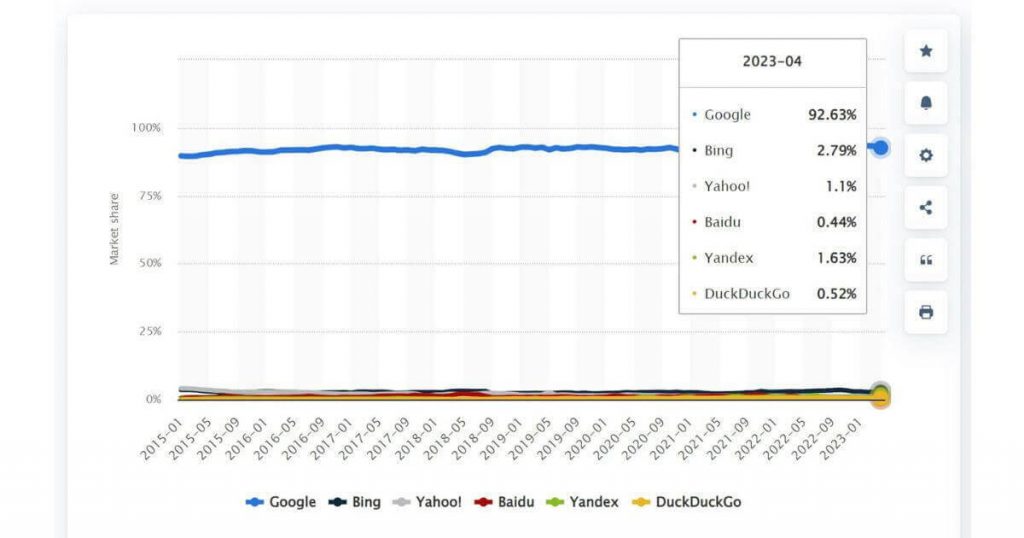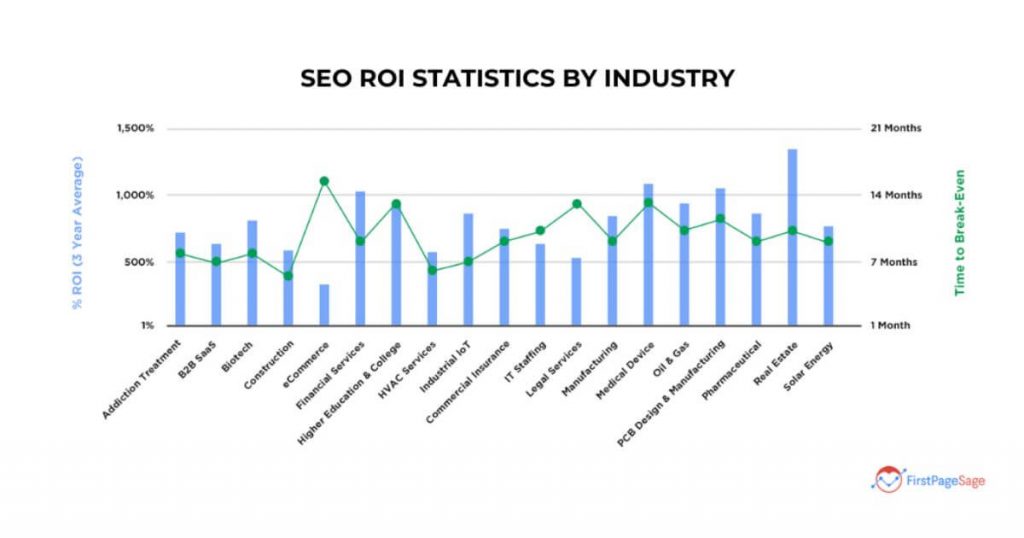Playback speed:
Search engine optimization (SEO) is an indispensable tactic if you want your business to rank organically online. SEO has evolved over the years, adapting to the changing search engines’ algorithms and users’ shifting preferences.
Being part of the dynamic digital world, SEO deserves its place as the ruler of organic growth and long-term inbound results.
This article is packed full of the latest SEO statistics for 2024, so prepare for a wealth of knowledge. Staying informed about the trends and stats will provide you with valuable insights, actionable data, and a better understanding of the field in general.
Let’s dive in!
Top SEO Stats and Facts in 2024 (Key Findings)
- A search engine is the starting point for 68% of online experiences.
- About 91% of online content doesn’t receive any search traffic from Google.
- Organic search is responsible for 53% of all website traffic.
- There are more than 3.5 billion searches on Google each day.
- 49% of marketing professionals state that organic search results bring the highest return on investment (ROI) out of all other digital marketing channels.
- 46% of all Google searches are performed with the intention of finding local information.
- The first Google result receives 32% of all search engine result page (SERP) clicks.
- 29% of marketers use an SEO-optimized site and blog to generate leads.
- SEO is the second most effective channel for acquiring new customers, with social media being the top performer.
Mobile SEO Statistics
With the mobile market’s rapid expansion, everything you could ever wish for is only a few clicks away at any given moment.
Consequently, when establishing an action plan, businesses investing in SEO must keep up with buyers’ continuously evolving navigation patterns and processes.
Given that data is marketers’ most powerful ally, below you’ll find some intriguing stats highlighting the importance of SEO mobile optimization.
- Mobile devices account for 58.33% of all website traffic worldwide.
- Position #1 on mobile typically yields a click-through rate (CTR) of 6.74%, compared to position #1 on desktop, which typically gets a CTR of 8.17%.
- When searching on mobile devices, 95% of consumers use Google.
- Mobile searches account for 65% of PPC clicks on Google.
- 58% of mobile users prefer businesses with apps or mobile-friendly websites that remember their behavior.
- 74% of mobile users say they would revisit a mobile-optimized website.
- 52% of people are less likely to engage with a company that offers a poor mobile navigation experience.
- 51% of mobile users have found a new company or product through organic search.
- As of October 2023, mobile device users worldwide equal 52.66%, compared to 45.56% of desktop users.

Image source: Stat Counter
Local SEO Statistics
Local SEO has significantly increased in importance, proving itself as a helpful resource and tactic, especially for small local businesses as a means to gain greater visibility for their brands.
With an expanded positive impact on businesses deploying it, local SEO seems to directly and substantially influence sales.
Here’s what local SEO stats data reveal:
- The conversion rate of local searches is 80% on average.
- 76% of people search online for local businesses before visiting them.
- 28% of local searches result in a purchase.
- 46% of Google searches have a local search intent.
- 19.9% of local businesses need help with on-site optimization.
- 50% of mobile users visit a store within a day after conducting a local search.
- 54% of smartphone users search for business hours among local information.
- A business on the first page of local search results is likely to be picked by around 92% of consumers.
- 35% of marketers agree that local SEO is important to businesses.
- The first result of local business searches receives 24.4% of all clicks.
- Mobile “near me” searches for nearby places rose by 200%.
- 82% of mobile shoppers have conducted a “near me” search on their phone.
- In over 50% of cases, the “near me” searches result in an offline store visit.
- 52% of smartphone shoppers use their phones to find nearby stores.
- Location-related queries comprise 30% of all mobile Google searches.
- 78% of local searches on mobile result in an offline purchase.
- 97% of people check a business’s online presence before visiting the physical location.
- For 18% of marketers, local link building is the most important local SEO strategy they want to invest in.
- Local queries account for 1.6 billion of Google’s annual searches.
- 40% of small- to medium-sized businesses outsource some of their local SEO operations.
- 58% of local businesses are not optimizing their sites for local SEO.

Image source: Review Trackers
Google Search Statistics
With Google’s constant updates in ranking algorithms, marketers’ challenge of creating SEO-optimized content only continues to intensify as time goes on.
For many companies, organic rankings and traffic may be the number one channel for generating brand awareness, leads, and sales. Therefore, keeping an eye on those changes and the consequences triggered is paramount for a business’s growth.
To help marketers gain knowledge of insightful SEO data and trends, here’s a comprehensive list of the latest search engine marketing stats for 2023.
- Google receives over 3.5 billion search queries every day.
- Google owns about 83.5% of the desktop search engine market.
- Google is the #1 search engine worldwide with a 92.63% market share.
- Approximately 91% of the content available online does not receive any traffic from Google.
- 75% of users don’t even scroll past the first page of Google search.
- Leads from search engines have a 14.6% close rate, while outbound leads (e.g., cold-calling, direct mail, etc.) have a 1.7% close rate.
- The first five organic results receive 69.1% of all clicks on the first page of search engine results.
- Compared to organic social media, search engine optimization generates 1,000% more traffic.
- A staggering 68% of all online experiences begin with a user conducting a search on a search engine.
Leading Search Engines by Market Share

Source: Statista
SEO ROI Statistics
One of the reasons businesses invest a great amount of time and resources in SEO is its incredible efficacy. And although SEO delivers results after a longer period of time, it offers an incredible return on investment.
To back this up with numbers, here is what the latest SEO statistics have revealed:
- The average timeframe to see ROI-positive results from local SEO is 4.76 months.
- SEO generates an average ROI of between 200%–275%.
- 49% of marketers say organic search has the highest ROI among digital marketing channels.
- Based on First Page Sage SEO ROI data, a thought leadership SEO service (focused on transactional keywords and high-quality blog posts) can generate a staggering 748% ROI.
- First Page Sage statistics also reveal that real estate is the industry with the highest SEO ROI of 1,389% over a three-year period. The average SEO ROI of all surveyed industries is 578%.

Image source: First Page Sage
SEO Industry Statistics
As with any other digital field, SEO doesn’t stand still—it’s constantly evolving. New opportunities and challenges emerge, and every SEO expert must adapt to such a dynamic environment.
Let’s look at the latest SEO industry stats and changes to have a better understanding of the digital landscape:
- For 29% of marketers, an SEO-optimized blog and website is a means of generating leads.
- 67.7% of SEO marketers use two to five SEO tools to do their work, with 12% using more than six tools/software products.
- Changes to SEO algorithms are important for 62% of B2B marketers.
- 72% of marketers consider content relevancy the most effective SEO factor.
- Marketers prioritizing blogging are 13 times more likely to see ROI.
- The Featured Snippet on Google gains 8.6% of all clicks.
- 88% of marketers using SEO plan to continue investing in it allocating the same or higher budget.
- 36% of SEO experts believe the headline/title tag is the most important SEO element.
- In terms of customer acquisition, SEO ranks second in effectiveness, surpassed only by social media.
Staying on top of business-to-business marketing trends may require hiring specialists. Take a look at these top B2B SEO agencies.
Keyword Research Statistics
In-depth keyword research is the key to SEO and content marketing success. To briefly highlight the impact that keyword research has, here are some insightful SEO stats for 2023:
- YouTube, Amazon, and Facebook (in that order) are the most searched for keywords in the United States as of November 2023.
- A page ranking #1 for a targeted keyword in Google gains a click-through rate (CTR) of 39.8%. In comparison, the second page gets a CTR of 18.7%, while the third gets only 10.2%.
- According to Backlinko, 92% of queries entered on search engines are long-tail keywords (more specific terms with lower search volume).
- Title tags that range from 40 to 60 characters tend to have the highest click-through rates.
- Longer keywords consisting of 10–15 words receive 1.76 times more clicks than one-word keywords.
- Short-tail keywords (search terms containing only one or two words) have shifted their search intent from transactional to informational. In the eyes of Google, they are perceived as not ready for purchase queries.
Backlink Statistics
Google uses backlinks as one of its ranking factors. External links are considered positive votes from other sites to yours and help with establishing authority.
Let’s take a look at interesting SEO facts regarding backlinks:
- According to search engine experts, the top three factors of an SEO-friendly site are content, keywords, and external links.
- For 85% of SEO professionals, link building has an enormous effect on brand authority.
- 67.5% of SEOs believe that backlinks have a significant impact on search engine rankings.
- 41% of marketers consider link building as the hardest part of SEO.
- For 18% of marketers, local link building is the most important local SEO strategy they want to invest in.
- Having a business blog results in 97% more indexed links and 434% more indexed pages.
- According to Semrush’s research, 55.1% of the websites without a single backlink never reach the top 10 Google search results.
- The first result ranking on Google has gained 3.8 times more backlinks on average than results 2 to 10.
Video SEO Statistics
The below video SEO stats offer a deeper understanding of how videos can influence search rankings, engagement, and audience behavior. They can shed light on why SEO content marketers and businesses need to develop effective video strategies.
- In 2023, an impressive 91% of businesses have adopted video as a powerful marketing tool in their strategies. That’s 5% up compared to 2022 when videos were used by 86% of surveyed companies.
- Video marketers experience a 66% increase in qualified leads compared to traditional strategies and a 54% boost in brand awareness.
- For 96% of marketing professionals, video content is an important part of their strategy.
- The top three most effective video channels for marketing are YouTube, LinkedIn, and Instagram, while the least effective is Snapchat.
- The most searched for keyword on YouTube is “minecraft” worldwide and “fortnite” in the US.
- The role of video as a content format is becoming more important according to 82% of marketers.
- The company website is the second marketing channel for video distribution after social media.
Voice Search Statistics
Voice SEO is a marketing tactic that focuses on optimizing your content to improve ranking in voice search results. This enhances your website’s chances of appearing as a top result when users ask voice-activated assistants like Alexa or Google Nest a question.
Let’s observe the growth of the voice sector in the following stats:
- 50% of American customers use voice search every day.
- With 67%, Amazon is the leader in the smart speaker market in the United States.
- 67% of US customers are very likely to use voice search when looking for information.
- Almost 41% of voice search answers originate from a Featured Snippet (the short excerpt at the top of Google results).
- Voice search answers are usually no longer than 29 words.
- Over 55% of customers utilize voice search with the purpose of finding local businesses.
- 42% of voice assistant owners use the voice search option to research a product before purchasing it.
Having individual pages answering every voice search query is an ineffective SEO strategy, as exact match title tags don’t boost voice search results.
Website Ranking Statistics
If you’re running a business or blog and want to improve your online presence, these website stats might be helpful:
- 47% of consumers expect a web page to load in 2 seconds or less.
- 53% of website traffic is driven by organic search.
- The website showing as the first listing on Google searches receives 32% of all clicks.
- Only 33% of small-to-middle-size businesses have optimized websites.
SEO vs. PPC Statistics
One of content marketers’ biggest curiosities is whether organic SEO or PPC is more successful in generating qualitative leads and increasing a business’s sales numbers.
To shed some light on that, let’s look at a couple of SEO vs. PPC stats and trends in 2023:
- 70% of online marketers say that SEO is better than PPC for generating sales.
- SEO offers 20 times more traffic opportunities than PPC.
- Paid search drives only 15% of website traffic, as opposed to 53% that comes from organic search.
Discover the power of SEO and PPC working together by reading our insightful article.
Final Thoughts
SEO can help businesses achieve a plethora of gains—from generating greater brand awareness to increasing sales.
When summarizing the insights revealed by all the SEO statistics presented today, one thing becomes clear—SEO is an indispensable element of the digital marketing arsenal for any business seeking long-term organic traffic.
SEO professionals need to excel in content creation, keyword research, and building backlinks as these are the three vital pillars for SEO success. Video and voice search are growing trends that also need attention.
References
- https://videos.brightedge.com/research-report/BrightEdge_ChannelReport2019_FINAL.pdf
- https://ahrefs.com/blog/search-traffic-study/
- https://www.internetlivestats.com/google-search-statistics/
- https://www.searchenginejournal.com/digital-marketing-channel-highest-roi/263757/#close
- https://www.seroundtable.com/google-46-of-searches-have-local-intent-26529.html
- https://backlinko.com/seo-stats
- https://www.hubspot.com/hubfs/2023+State+of+Marketing+Report.pdf
- https://www.hubspot.com/hubfs/2022_State-of-Inbound-Marketing-Trends_V712.pdf
- https://www.statista.com/statistics/277125/share-of-website-traffic-coming-from-mobile-devices/
- https://www.seoclarity.net/mobile-desktop-ctr-study-11302/
- https://gs.statcounter.com/search-engine-market-share/mobile/worldwide
- https://www.jumpfly.com/blog/mobile-and-paid-search-why-its-still-a-big-deal/
- https://blog.hubspot.com/website/mobile-optimization-stats
- https://www.brightervision.com/blog/importance-mobile-friendly-website/
- https://www.leadpages.com/blog/ux-statistics
- https://seo.ai/blog/seo-statistics
- https://gs.statcounter.com/platform-market-share/desktop-mobile-tablet
- https://growbydata.com/how-to-optimize-for-local-seo/
- https://www.prnewswire.com/news-releases/76-of-consumers-look-at-online-presence-before-physically-visiting-a-business-301272462.html
- https://www.thinkwithgoogle.com/consumer-insights/consumer-trends/local-search-conversion-statistics/
- https://moz.com/the-state-of-local-seo-industry-report-2020/local-seo-strategy
- https://think.storage.googleapis.com/docs/how-advertisers-can-extend-their-relevance-with-search_research-studies.pdf
- https://financesonline.com/local-seo-statistics/
- https://seotribunal.com/blog/stats-to-understand-seo/#local-seo-facts
- https://www.safaridigital.com.au/blog/local-seo-statistics/
- https://uberall.com/en-us/company/press-releases/study-82-of-mobile-shoppers-doing-near-me-searches
- https://www.webfx.com/local-seo/statistics/
- https://99firms.com/blog/local-seo-statistics/
- https://moz.com/the-state-of-local-seo-industry-report-2020/local-seo-in-the-organization
- https://www.reviewtrackers.com/reports/local-search/
- https://www.statista.com/statistics/216573/worldwide-market-share-of-search-engines/
- https://www.statista.com/statistics/1381664/worldwide-all-devices-market-share-of-search-engines/
- https://cdn2.hubspot.net/hubfs/1428728/inbound-marketing-infographic-1-1-1.pdf
- https://neilpatel.com/blog/first-page-google/
- https://upinc.co/organic-vs-ppc-2023-ctr-results-best-practices/
- https://ahrefs.com/blog/seo-statistics/
- https://neilpatel.com/blog/loading-time/
- https://fathershops.com/importance-of-seo-in-ecommerce-business/
- https://databox.com/seo-vs-ppc
- https://moz.com/beginners-guide-to-seo/why-search-engine-marketing-is-necessary
- https://profitworks.ca/blog/442-roi-of-organic-seo-traffic-vs-social-media-traffic
- https://firstpagesage.com/reports/seo-roi-statistics-fc/
- https://www.hubspot.com/state-of-marketing
- https://www.smamarketing.net/blog/80-seo-statistics
- https://contentmarketinginstitute.com/wp-content/uploads/2021/10/B2B_2022_Research.pdf
- https://optinmonster.com/blogging-statistics/
- https://searchengineland.com/another-featured-snippet-study-shows-steal-significant-traffic-first-organic-result-275967
- https://coschedule.com/blog/seo-title-tags
- https://explodingtopics.com/blog/top-google-searches
- https://firstpagesage.com/reports/google-click-through-rates-ctrs-by-ranking-position/
- https://backlinko.com/hub/seo/long-tail-keywords
- https://backlinko.com/google-ctr-stats
- https://www.conductor.com/academy/ecommerce-seo-trends/
- https://databox.com/seo-friendly-website
- https://userp.io/state-of-backlinks-for-seo/
- https://www.authorityhacker.com/link-building-statistics/
- https://searchengineland.com/local-seos-most-focused-on-link-building-and-content-development-report-finds-335976
- https://www.demandmetric.com/content/content-marketing-infographic
- https://www.semrush.com/blog/how-long-does-it-take-to-rank/
- https://backlinko.com/search-engine-ranking
- https://www.wyzowl.com/video-marketing-statistics/
- https://www.mikegingerich.com/blog/video-marketing-how-to-generate-more-qualified-leads/
- https://www.semrush.com/blog/most-searched-on-youtube/
- https://awesome.vidyard.com/rs/273-EQL-130/images/2022-Vidyard-State-of-Video-Report.pdf
- https://upcity.com/experts/consumers-and-voice-search-study/
- https://www.statista.com/chart/29167/smart-speaker-ownership-in-the-us/
- https://backlinko.com/voice-search-seo-study
- https://www.webfx.com/blog/marketing/voice-search-digital-marketing-2019/
- https://smallbiztrends.com/2020/03/voice-assistant-trends.html



